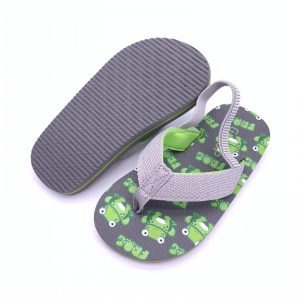When looking for lasting kids’ flip flops, the choice of materials plays a crucial role in their durability, comfort, and overall lifespan. Here are some materials to consider for flip flops that are built to last:
- EVA (Ethylene Vinyl Acetate): EVA is a lightweight and durable foam material commonly used in flip flops. It provides excellent cushioning, shock absorption, and flexibility. Look for flip flops with EVA midsoles and outsoles for a comfortable and long-lasting option.
- Rubber: Natural or synthetic rubber is a popular choice for flip flop soles. Rubber provides good grip, durability, and resistance to wear and tear. It’s especially suitable for flip flops intended for water activities or outdoor use.
- Polyurethane (PU): PU is another foam material that offers cushioning, comfort, and durability. It’s often used in midsoles and footbeds of flip flops, providing support for the feet while being resilient against everyday use.
- Neoprene: Neoprene is a synthetic rubber material known for its water resistance and flexibility. Flip flops with neoprene straps can withstand exposure to water and moisture without losing their shape.
- Webbing: Webbing straps, usually made of nylon or polyester, are strong and durable. They are less likely to stretch out or break over time compared to some other strap materials.
- Microfiber: Microfiber is a synthetic material that can mimic the feel of leather. It’s durable, water-resistant, and easy to clean. Microfiber-lined footbeds can also enhance comfort.
- Textile Fabrics: Some flip flops incorporate durable textile fabrics in their construction. Look for flip flops with reinforced textile straps and lining for increased longevity.
- Stitching: Pay attention to how the flip flops are constructed. Double-stitched or reinforced stitching in critical areas can prevent the sole from separating from the straps, increasing the flip flops’ lifespan.
- Anti-Microbial Treatments: Some flip flops feature anti-microbial treatments on the footbeds or straps. These treatments can help prevent odors and bacterial growth, leading to a longer-lasting and more hygienic product.
- Avoid Cheap Plastics: While flip flops made from low-quality plastics might be inexpensive, they are less likely to last long and might not provide adequate support or comfort.
When choosing materials for lasting kids’ flip flops, it’s important to strike a balance between durability, comfort, and style. You can also consider looking for reputable brands known for their quality and craftsmanship. Additionally, proper care, such as rinsing off sand and dirt and allowing the flip flops to dry after use, can contribute to their longevity.















